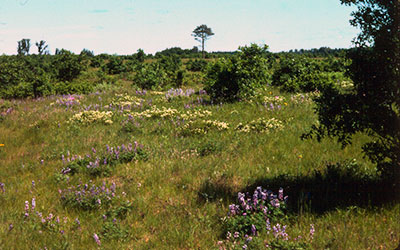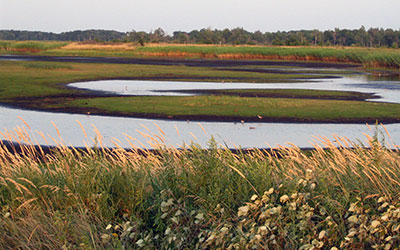Site Description
This 30,000 acre site is the largest property in the Glacial Lake Grantsburg Wildlife Management Complex. Over half of this acreage consists of wetland communities, primarily sedge marshes and sedge meadows, but also deep-water marsh and flowages. There also are significant acreages of grassland, restored brush-prairie, and forests of oak, jack pine, and aspen. Barrens, shrubland, and grassland restorations are ongoing. Crex Meadows offers some of the best wildlife viewing opportunities in the state.

Crex Meadows Prairie, photo by Jim Hoefler

Crex Meadows State Wildlife Area, photo by Andy Paulios
Ornithological Importance
This site provides critical habitat for numerous high-priority species. It is the original release site for the Wisconsin trumpeter swan recovery program and maintains a robust population of trumpeters. The extensive sedge meadows and marshes contain breeding American bitterns, yellow rails, red-necked grebes, black terns, blue-winged teal, ring-necked ducks, hooded mergansers, sedge wrens, Le Conte’s sparrows and Nelson’s sharp-tailed sparrows. Barrens, shrublands, and grasslands host sharp-tailed grouse, northern harrier, upland sandpiper, American woodcock, short-eared owl, red-headed woodpecker, brown thrasher, golden-winged warbler, chestnut-sided warbler, Connecticut warbler, field sparrow, and bobolink, among others. Thousands of staging waterfowl and sandhill cranes use the wetlands during migration. In addition, shorebird staging habitat is promoted though drawdowns on approximately 10% of the wetlands on an annual basis, providing habitat for species such as marbled godwit, Hudsonian godwit, stilt sandpiper, short-billed dowitcher, greater yellowlegs, and lesser yellowlegs. Crex is one of the few sites in Wisconsin that provides landscape-level management opportunities for pine-oak barrens, northern sedge meadows and marshes, and emergent marsh/wild rice habitats. It is considered a critical IBA.